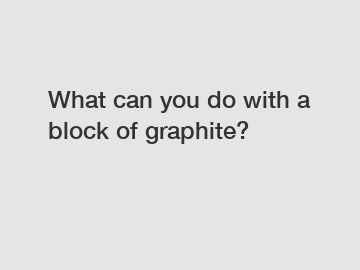What can you do with a block of graphite?
What can you do with a block of graphite?
Graphite is a unique material that has a wide range of applications due to its exceptional properties. From pencils to nuclear reactors, its versatility has made it an indispensable material across various industries. In this article, we will explore the countless possibilities of what can be done with a block of graphite.
1. Pencils and Graphite Writing Instruments:

When we think of graphite, the first thing that comes to mind is pencils. Graphite's ability to leave a mark on paper effortlessly makes it an ideal material for writing instruments. Pencil leads are often made from a mixture of graphite and clay, allowing for different levels of hardness and darkness. These common writing tools would not be the same without the versatility of graphite.
2. Lubricants and Industrial Applications:
Graphite is an excellent lubricant due to its natural slippery properties. It can withstand high temperatures and pressures, making it suitable for various industrial applications. Graphite lubricants are used in machinery, automotive parts, and even locks and hinges. The use of graphite as a lubricant helps minimize friction and reduce wear and tear, thereby extending the lifespan of equipment.
3. Crucibles and Refractories:
Graphite's high melting point and resistance to heat make it an ideal material for crucibles and refractories. Crucibles made of graphite are commonly used in metallurgical industries for melting and holding high-temperature materials like metals and alloys. Similarly, refractories, which are materials that can withstand extreme temperatures, often contain graphite. Its ability to withstand heat without melting or deforming makes it invaluable in various manufacturing processes.
4. Batteries and Energy Storage:
Graphite plays a significant role in modern technology through its use in batteries and energy storage. Lithium-ion batteries, extensively used in smartphones, laptops, and electric vehicles, contain graphite anodes. Graphite's ability to intercalate lithium ions allows for the storage and release of electrical energy. As renewable energy sources gain prominence, graphite will continue to be a crucial component in advanced battery technologies.
5. Nuclear Reactors and Moderators:
Graphite's fascinating properties also find applications in nuclear reactors. In nuclear power plants, graphite is often used as a moderator, a material that slows down neutrons and enhances the efficiency of nuclear fission. Its thermal properties and low neutron absorption make it suitable for this critical role in safeguarding nuclear reactions.
6. Graphene Production:
Graphene, a single layer of graphite arranged in a two-dimensional lattice, has gained significant attention for its extraordinary properties. Graphene is one of the thinnest, strongest, and most conductive materials known to man. It has the potential for revolutionizing electronics, energy storage, and environmental applications. By isolating graphene from graphite, researchers can unlock its incredible properties and explore its numerous applications.
In conclusion, the question of what can be done with a block of graphite has countless answers. From everyday objects like pencils to complex applications such as nuclear reactors and graphene production, graphite has proven its versatility time and again. As technology continues to advance, it is exciting to ponder the infinite possibilities that lie ahead for this remarkable material.
If you want to learn more, please visit our website carbon artificial graphite block Supplier, Graphite Block, China Graphite Block for Blast Furnace.
231
0
0

Comments
All Comments (0)